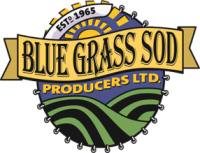Spring in Manitoba brought exceptionally dry conditions, leaving not only the spring flowers missing refreshing showers, but also leaving lawns parched and in need of relief. Despite some rainfall, it hasn’t been enough to provide significant hydration.
Understanding the Signs of Drought:
Recognizing the signs of drought is crucial in maintaining a healthy and vibrant lawn. Indications such as thinning grass blades, changes in color, and lingering footprints are clear indicators of an established lawn in need of water. To sustain its health and lush appearance, adequate watering is essential. On average, a lawn requires approximately 2.5-3.5 cm (1-1.5 inches) of water per week.
Caring for Newly Laid Sod:
Newly laid sod requires special attention as it is particularly susceptible to damage from insufficient watering. When investing in fresh sod, it reflects your commitment and pride as a homeowner. Neglecting its care can hinder its establishment and overall well-being. Inadequate watering stands out as a crucial factor that significantly influences the success of new sod.
Recognizing Signs of Underwatering:
To ensure the vitality and resilience of your recently transplanted turf, promptly identifying signs of underwatering is critical. Watch out for unmistakable indicators such as wilting or straw-colored grass, rapid browning, browning edges on sod pieces, a burnt appearance, or spaces and gaps appearing between sod pieces or rows.
Steps to Correct Underwatering:
If you notice any signs of underwatering, it’s crucial to take immediate action to rectify the situation.
Here are steps you can take to correct underwatering:
Increase watering frequency: If you suspect your new sod is not receiving enough water, increase the frequency of watering sessions. Aim to water your lawn more often, ensuring consistent soil moisture without waterlogging.
Adjust watering duration: Along with increased frequency, adjust the duration of each watering session. Water your new sod deeply enough to penetrate the root zone, promoting healthy growth.
Monitor soil moisture: Regularly check the moisture level of the soil to gauge if it’s receiving adequate water. You can use a moisture meter or simply insert your finger into the soil to assess the moisture level. Adjust your watering schedule accordingly to maintain proper soil moisture.
Consider time of day: The timing of watering can impact hydration effectiveness. Watering early in the morning or late in the evening helps minimize water loss due to evaporation and allows the new sod to absorb moisture efficiently.
Other quick tips:
-Set a timer when watering. It will help you keep watering times & amounts uniform throughout the yard.
-Use a shallow container such as an empty tuna can or pie dish to track how much water your lawn has received.
-Check how far & where the sprinkler is actually reaching. Strong breezes and windy conditions can push the water from sprinklers off target.
-Pay particular attention to areas that your new sod is contact with or surrounded by concrete driveways, walkways, stone or pavers as these surfaces attract heat and dry out the soil & grass around them. The sod in those areas will require more water.
By following these steps and giving your new sod the attention it needs, you can correct underwatering and foster a thriving, vibrant lawn.
Remember, proper watering practices are key to your new sod’s survival.
Special Note: When installing new sod, it must be watered immediately. Water should be applied to sod within 30 minutes of an area being completed. Freshly installed sod must be thoroughly soaked through its root mat and at least 5 cm (2 inches) into the topsoil underneath. For even more watering information go to our How to Prep & Install Sod page.

